Rip Current Safety Tips

Learn how to swim!
When at the beach:
- Whenever possible, swim at a
lifeguard-protected beach.
- Never swim alone.
- Learn how to swim in the surf. It's not the same as swimming
in a pool or lake.
- Be cautious at all times, especially when swimming at unguarded
beaches. If in doubt, don’t go out.
- Obey all instructions and orders from lifeguards. Lifeguards are
trained to identify potential hazards. Ask a lifeguard about the
conditions before entering the water. This is part of their job.
- Stay at least 100 feet away from piers and jetties. Permanent rip
currents often exist along side these structures.
- Consider using polarized sunglasses when at the beach. They will
help you to spot signatures of rip currents by cutting down glare
and reflected sunlight off the ocean’s surface.
- Pay especially close attention to children and elderly when at the
beach. Even in shallow water, wave action can cause loss of footing.
If caught in a rip current:
- Remain calm to conserve energy and think clearly.
- Never fight against the current.
- Think of it like a treadmill that cannot be turned off, which you
need to step to the side of.
- Swim out of the current in a direction following the shoreline.
When out of the current, swim at an angle--away from the
current--towards shore.
- If you are unable to swim out of the rip current, float or calmly
tread water. When out of the current, swim towards shore.
- If you are still unable to reach shore, draw attention to yourself
by waving your arm and yelling for help.
If you see someone in trouble,
don't become a victim too:
- Get help from a lifeguard.
- If a lifeguard is not available, have someone call 9-1-1.
- Throw the rip current victim something that floats--a lifejacket,
a cooler, an inflatable ball.
- Yell instructions on how to escape.
- Remember, many people drown while
trying to save someone else from a rip current.
|
Rip Current Science
top
Where and Why Rip Currents Form
Coastal scientists have been investigating rip currents for more than 75
years. This research has been conducted through field observations and
measurements, laboratory measurements and wave tank experiments, and computer
and numerical modeling. The mechanics of rip current development are complex and
involve interactions between waves and currents, waves and water levels, waves
and the shape of the nearshore bottom (bathymetry), as well as wave-wave
interaction.
|

Photo courtesy University of Delaware Sea
Grant College Program
|
Rip currents can occur along any coastline that features breaking waves.
Scientific investigations of wave and current interactions along the coast have
shown that rip currents are likely present on most beaches every day as a
component of the complex pattern of nearshore circulation.
As waves travel from deep to shallow water, they eventually break near the
shoreline. As waves break, they generate currents that flow in both the offshore
(away from the coast) and the alongshore directions. Currents flowing away from
the coast are called rip currents.
Rip currents are a result of complex interactions between waves, currents,
water levels and nearshore bathymetry. These current systems form an integral
part of nearshore circulation patterns such as alongshore and cross-shore
(onshore/offshore) water motion. Along all coastlines, nearshore circulation
cells may develop when waves break strongly in some locations and weakly in
others. These weaker and stronger wave breaking patterns are most often seen on
beaches with a sand bar and channel system in the nearshore zone. A rip current
forms as the narrow, fast-moving section of water travels in an offshore
direction. Rip currents can also result from a wave's natural variability or
when a current traveling along the shoreline encounters a structure such as a
groin or jetty and is forced offshore.
Rip current strength and speed varies. This variability makes rip currents
especially dangerous to uninformed beachgoers. Rapid fluctuations or pulses in
wave groups can quickly generate rip currents with velocities measured up to 8
feet per second.
Waves, Currents and Water Level Variations
As waves break along a shoreline or over a sandbar, an increase in water
level occurs. This increase in water level is known as set-up. The increase in
water level is especially evident as waves break over a sandbar, resulting in an
increased set-up of water on the landward side of the bar. Thus, waves breaking
over a sandbar can result in mass transport of water between the bar and the
shoreline. There is usually a difference in set-up (water heights) between the
bar, where the waves are breaking strongly, and the channel between bars, where
little or no wave breaking occurs.
One of the ways this water returns seaward is through rip currents, which
flow seaward against the incoming waves. This seaward flow of water typically
occurs through a break in the sandbar, where water is channelized into a narrow
current known as a rip current.
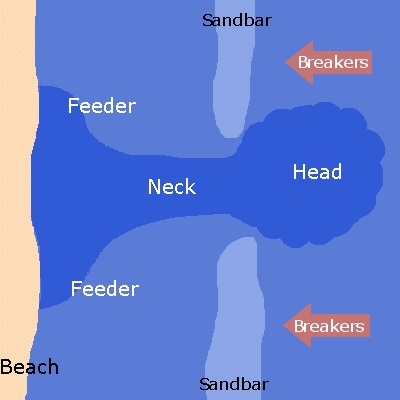
Diagram courtesy NOAA's National Weather
Service |
Brian Sapp, a graduate student at the Georgia-Tech Savannah, has provided the
following explanation of how a rip current develops over a sand bar. The
accompanying graphic is provided courtesy of NOAA-National Weather Service:
Basic Rip Current Mechanics
- Waves break on the sand bars before they break in the channel area.
- Wave breaking causes an increase in water level over the bars relative to
the channel level.
- A pressure gradient is created due to the higher water level over the
bars.
- This pressure gradient drives a current alongshore (the feeder current).
- The longshore currents converge and turn seaward, flowing through the low
area or channel between the sand bars.
Nearshore Bottom: Bathymetry
The shape of the shoreline and nearshore bottom (bathymetry) may influence
rip current development. In regions where the coastline is characterized by
cuspate features (i.e. the shoreline is “scalloped”), rip current may be
found between the cusps. Examples of this type of shoreline can be found in some
portions of the Florida coast (e.g. Perdido Key), and in some locations along
the California coast (Monterrey Bay).
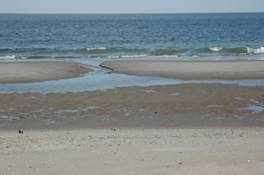
View from the ground and taken at low tide; this channel has formed at a
break in the sand bar. Photo courtesy
University of Delaware Sea Grant College Program |

Viewed from the air, rip currents can be seen flowing past the line of
breaking waves. Rip current spacing along an open coast may be dependent
on many factors, including the shape of the nearshore bottom. Photo
courtesy University of Delaware Sea Grant College Program . |
top
The presence of longshore bars can also have an impact on rip current
development and location. In some geographic locations, the nearshore bottom may
be characterized by fixed structures such as reefs. In other areas, nearshore
bathymetry is more ephemeral, with offshore sand bars constantly changing their
shape and location. Along shorelines where sand is deposited in an offshore bar,
the rip current often flows through a low spot or channel cut through the
sandbar.
Man-Made Structures
Rip currents may occur at fixed locations such as groins, jetties, piers, or
other man-made structures where water can be funneled out to sea in a narrow
channel. In coastal areas with structures, rip current may result when currents
running parallel to the shore are deflected offshore by the structure.
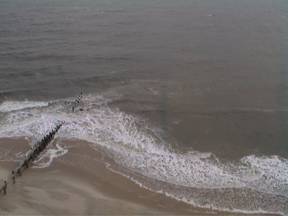
Brownish-colored water can be seen flowing seaward, deflected offshore
by the timber groin. Photo courtesy University
of Delaware Sea Grant College Program |
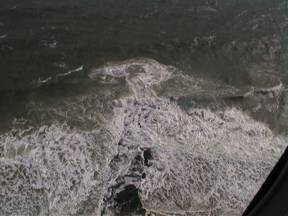
Rip current formation adjacent to coastal structure. Currents that flow
in the longshore direction are deflected offshore by structures. Photo
courtesy University of Delaware Sea Grant College Program. |
As waves approach the shoreline, they usually break at an angle, generating a
longshore current that flows parallel (along) the beach. When the longshore
current (moving along the shore) encounters coastal structure (such as a groin,
jetty, or pier) it is deflected in an offshore direction. This offshore-directed
flow of water is called a rip current.
Wave-Wave Interaction and Wave-Current Interaction: Generation of
Circulation Patterns
Rip currents can develop due to interactions between waves and currents, even
in the absence of nearshore sand bars and without shoreline or bathymetric
influence on their formation. Breaking waves force narrow regions of
offshore-directed flows, known as rip currents.
As waves break near the shore, complex wave interactions may generate
circulation patterns that result in the formation of rip currents, sending water
back out to sea. Along open coasts (coasts without sand bars), rip currents are
caused by variations in breaking waves, with waves breaking strongly in some
locations and less strongly in others. These variations generate circulation
cells causing water to be deflected offshore as a rip current.
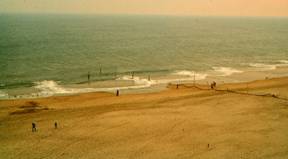
Periodic rips: Beach face currents along the coast of Germany.
Photo courtesy of Dr. Robert A. Dalrymple. |
Rip Current Size and Speed
Rip currents can occur along any coastline with breaking waves. Although rip
currents are often present daily on many beaches, the velocities may be too slow
to be a threat to experienced swimmers. However, their inherent variability
makes them especially dangerous to unwary or uninformed beachgoers. Changes in
the size of the incoming waves can cause pulses in the strength of a rip
current, which can be dangerous to all swimmers and anyone entering the surf.
Wave Groups and Rip Current Pulsations
Rip currents are very unsteady and may increase in strength within a short
time frame (a few minutes) because of larger incoming wave groups or current
instabilities. It is extremely important to understand that changes in rip
current velocity can occur very rapidly with random increases in incoming wave
heights and water levels. Water depths can rapidly increase in rip current
channels, catching unwary beachgoers and swimmers off-guard. If the higher waves
and water levels sweep bathers off their feet, they may be transported offshore
by the rip current.
Rip Current Characteristics and Velocities
Although rip currents are not caused by tides, the water level (tide
elevation) at the coast may have an impact on rip current speed and strength.
Generally, rip current velocities increase as water levels (tide elevation)
decrease.
Rip current velocities also typically increase as wave heights increase. An
increase in the height of incoming waves can result in sudden increases in water
depth and rip current velocities. These sudden changes or pulses in water depth
and current speed can catch bathers off-guard. Rip current pulsations are
extremely dangerous to all swimmers!
While average rip current velocities of 1 to 2 feet per second do not pose
serious hazards to strong swimmers, rip currents may rapidly reach or exceed
velocities of 3 feet per second. Also, rapid fluctuations or pulses in wave
groups can quickly generate rip currents with extreme velocities that have been
measured up to 8 feet per second – this is faster than an Olympic swimmer can
sprint! If a swimmer is caught in a rip current, attempting to swim directly
back to shore against the seaward flowing current can result in exhaustion and
possible drowning.
Rip currents are usually narrow (~ 20 to100 feet in the alongshore
direction), may extend hundreds of feet offshore, and generally span the entire
water column. However, offshore, or outside the surf zone, they tend to be
confined near the surface.
Rip currents do not pull people under water – they pull people away from
shore. Drowning deaths usually occur when people are unable to keep themselves
afloat and swim back to shore. This may be due to fear, panic, exhaustion, a
lack of swimming skills, or any combination of these factors.
Rip Current Duration
Some shorelines are characterized by permanent rip currents which may be
found in a fixed location such as a break in a reef or other hard structure.
Some rip currents are persistent, lasting for many days or months in one
location. Rip currents may also migrate along a stretch of coastline. Rip
currents may also be ephemeral, forming quickly and lingering for a few hours or
days before dissipating and disappearing.
Miscellaneous/General Information
Rip Currents vs. Rip Tides
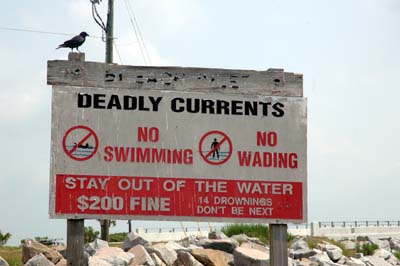
Warning sign posted adjacent to tidal inlet in South Carolina. Photo
courtesy University of Delaware Sea Grant College Program |
Rip currents are not rip tides. A specific type of current associated with
tides may include both the ebb and flood tidal currents that are caused by
egress and ingress of the tide through inlets and the mouths of estuaries,
embayments, and harbors. These currents may cause drowning deaths, but these
tidal currents or tidal jets are separate and distinct phenomena from rip
currents. Recommended terms for these phenomena include ebb jet , flood
jet , or tidal jet .
What is Undertow?
Undertow, an often misunderstood term, refers to the backwash of a wave along
the sandy bottom. After a wave breaks and runs up the beach face, some of the
water percolates into the sand, but much of it flows back down the beach face
creating a thin layer of offshore-moving water with a relatively high velocity.
This backwash can trip small children and carry them seaward. However, the next
incoming wave causes higher landward velocities, pushing them back up on the
beach. Undertow does not pull you under water or out to sea.
For additional science and information on rip currents, see our links
and Frequently Asked
Questions pages.
This page was developed courtesy of Wendy Carey, Delaware Sea Grant.
Assistance and input provided by Dr. Andrew Kennedy, University of Florida,
Gainesville; Dr. Jamie MacMahan, University of Delaware; Brian Sapp, Georgia
Tech, Savannah; Spencer Rogers, North Carolina Sea Grant; and the many rip
current research scientists who participated in the Rip Current Technical
Workshop held in April, 2004.
___________________________
above content from NOAA /National Weather Service
Back to Public Information page.







